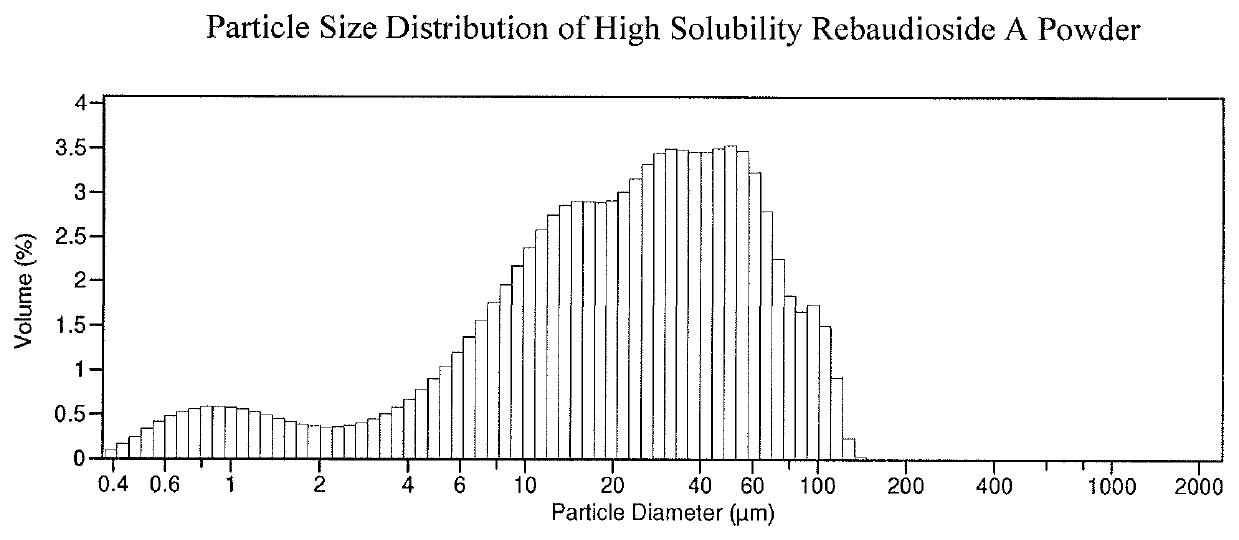Granulation of a Stevia sweetener
a stevia sweetener and granulation technology, applied in the field of stevia sweetener granulation, can solve the problems of increased blood glucose level, dusty handling during food application processing, imbalance in temporal and/or flavor profile, etc., and achieves the effects of reducing the particle size of stevia sweetener powder, reducing pressure, and high solubility
- Summary
- Abstract
- Description
- Claims
- Application Information
AI Technical Summary
Benefits of technology
Problems solved by technology
Method used
Image
Examples
example 1
Preparation of High Solubility Rebaudioside A
[0071]100 kg of Rebaudioside A, containing Stevioside 0.2%, Rebaudioside C 0.2%, Rebaudioside F 0.3%, Rebaudioside A 97.5%, Rebaudioside D 1.1%, Rebaudioside B 0.5%, all percentages being on a percent dry weight basis, and having water solubility of 1.6% was placed into rotary blade milling machine and pulverized for 20 minutes. The resulting powder was analyzed by Beckman Coulter LS 13 320 Laser Diffraction Particle Size Analyzer. The results are summarized in Table 5.
[0072]
TABLE 5Powder Laser Diffraction Analysis ResultsVolume StatisticsOperation ModeCalculations:from 0.375 μm to 2000 μmMean:31.07μmMedian:23.11μmMean / Median ratio:1.344Mode:50.22μmS.D.:27.15μmVariance:737.4μm2C.V.:87.4%Distribution3.356μm10.11μm23.11μm45.76μm70.19μm
[0073]The obtained powder was loaded into a 1000 L rotary vacuum dryer and dried at 105° C. at 10 mbar pressure for 3 hours. After 3 hours, preheated nitrogen at 100° C. was introduced into the vacuum chamber ...
example 2
Granulation of Rebaudioside A
[0074]50 kg of high solubility Rebaudioside A prepared according to EXAMPLE 1 was placed into a 500 L double cone powder mixer and nitrogen at 10° C. was fed to the vessel for 1 hour. The powder was transferred to Alexanderwerk WP 50N / 75 roller compactor. The compactor was operating at 9 rpm and 45 bar pressure. The compacted mass was fed to a pre-granulator and a fine granulator with rotors at rotating at 150 rpm. The screen size for the pre-granulator was 3.1 mm and for the fine granulator was 1.6 mm. The “overs” (particles that are too large) and “fines” (particles that are too small) were separated by top screen having a screen size of US Mesh 10 and bottom screen of US Mesh 40. The % ratio of “overs”:“product”:“fines” was 0.3%:72.1%:27.6% respectively.
example 3
Granulation of Rebaudioside A
[0075]50 kg of high solubility Rebaudioside A prepared according to EXAMPLE 1 were granulated according to procedure of EXAMPLE 2. The compactor was operating at 18 rpm and 65 bar pressure. The compacted mass was fed to a pre-granulator and a fine granulator with rotors at rotating at 300 rpm. The screen size for the pre-granulator was 5 mm and for the fine granulator was 3 mm.
PUM
 Login to View More
Login to View More Abstract
Description
Claims
Application Information
 Login to View More
Login to View More - R&D
- Intellectual Property
- Life Sciences
- Materials
- Tech Scout
- Unparalleled Data Quality
- Higher Quality Content
- 60% Fewer Hallucinations
Browse by: Latest US Patents, China's latest patents, Technical Efficacy Thesaurus, Application Domain, Technology Topic, Popular Technical Reports.
© 2025 PatSnap. All rights reserved.Legal|Privacy policy|Modern Slavery Act Transparency Statement|Sitemap|About US| Contact US: help@patsnap.com

